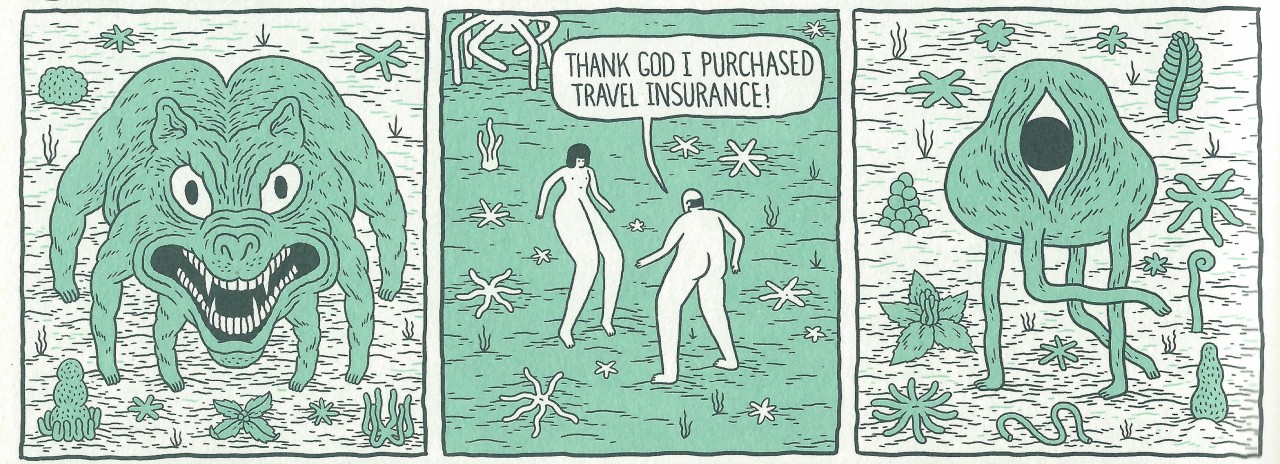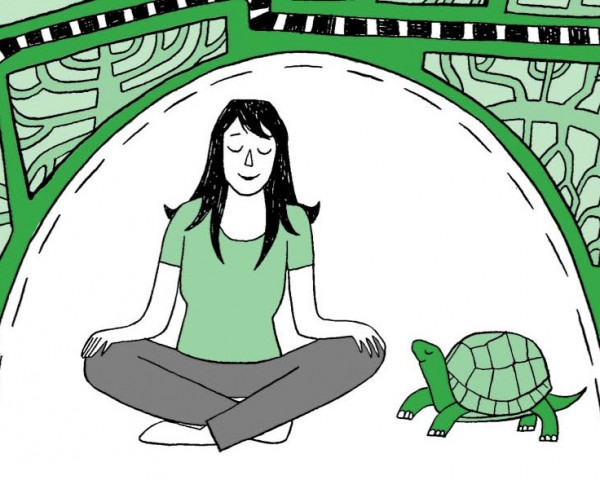
The primeval forest in Jesse Jacobs’ new book, Safari Honeymoon, is filled with poisonous plants, strange creatures, and deadly parasites. The two honeymooners, far from their condo in the city, find comfort in the domestic amenities offered by their private safari, such as a luxurious bed, gourmet meals, and the illusion that someone (their guide) can keep the wild at bay. Jacobs plays with our anxiety about nature by turning the forest inhabitants into one-eyed, many-legged, slithering, toothy, tentacled predators that can devour you, strangle you, pass through your rectum, take over your brain, feed upon your soul, or worse – swim in your glass of Chardonnay.
The forest is alive and awake. Groups of trees with faces speak directly to the reader, and the entire forest is revealed to be the head of an enormous being high in the clouds, as if everything that lives from it – the protagonists included – are parasites. Monkeys, born from plants, roam and communicate telepathically, as if they are part of the forest’s neural pathways. In some areas, the protagonists may suddenly find themselves underwater or inside pockets of temporal disruptions.


Of all the bizarre plants and animals, however, the most frightening character in the book is the safari guide. The guide, a master of wilderness survival and a talented chef, deals skillfully with any situation that threatens the couple’s lives or pleasure. He kills predators, rescues the wife, and punches the husband in the face to dislodge a parasite. The husband, who is powerful back home, appears feeble beside the guide (who flirts with his wife). The guide, seen by the husband, becomes a threat to the romance promised by their honeymoon.
He never sleeps. Or, we learn, he sleeps with only half of his brain so that he may remain alert at all times. He is full of parasites, to the point where he has formed a symbiotic relationship with them. His tongue was replaced by the creature that devoured it. Every life-threatening crisis often ends in the guide shooting something dead, after which he presents a meticulously crafted gourmet meal to the couple (aided by, he says, his parasite-tongue). He becomes a symbol of an aggressive, civilizing force, imposing domesticity on a feral environment.
Jacobs describes the transformation of a domestic pig into a large, hairy, aggressive beast after its release into the wild. “Everything, at some point, is reduced to its most primitive state,” he writes. The grilled croque-monsieur with crème fraîche and gruyère topped with an organic quail egg is as much a representation of their fight against the wild as is the guide’s rifle. At first, the conflict for the characters is between civilization and nature.

The monkeys offer an alternative to the conflict. They move freely through the space (and it appears, time) of the forest, unaffected by predators and parasites. Late in the book, we see that they have a vegetable garden, their own form of domesticity. The guide becomes an embodiment of the “man vs. nature” conflict, while the monkeys argue not that man risks be defeat or consumption by nature, but that man is nature. They remove themselves from that conflict. The true struggle is between the worldview of guide and that of the monkeys, and the central question of the comic becomes which side the couple will choose.

 Festival Season
Festival Season 




